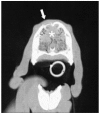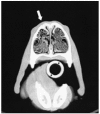Successful treatment of nasal sporotrichosis in a dog
- PMID: 17494369
- PMCID: PMC1831506
Successful treatment of nasal sporotrichosis in a dog
Abstract
Sporotrichosis is an uncommon mycosis of dogs caused by Sporothrix schenckii. This report details the diagnosis and treatment of intranasal sporotrichosis in a dog presented for a loss of smell, sneezing, and nasal congestion. Following 6 months of itraconazole treatment, a computed tomography scan showed a complete resolution of previously identified abnormalities.
Traitement réussi de sporotrichose chez un chien. La sporotrichose est une mycose rare chez les chiens causée par Sporothrix schenckii. Ce rapport décrit en détail le diagnostic et le traitement d’une sporotrichose nasale chez un chien présenté pour une perte d’olfaction, pour éternuements et congestion nasale. Après 6 mois de traitement à l’itraconazole, une tomographie par reconstruction d’image a montré une disparition complète des anomalies précédemment identifiées.
(Traduit par Docteur André Blouin)
Figures



Similar articles
-
Successful Treatment of Canine Sporotrichosis with Terbinafine: Case Reports and Literature Review.Mycopathologia. 2018 Apr;183(2):471-478. doi: 10.1007/s11046-017-0225-6. Epub 2017 Dec 8. Mycopathologia. 2018. PMID: 29222709 Review.
-
Lymphocutaneous and nasal sporotrichosis in a dog from southern Italy: case report.Mycopathologia. 2007 Feb;163(2):75-9. doi: 10.1007/s11046-006-0086-x. Epub 2007 Feb 10. Mycopathologia. 2007. PMID: 17294354
-
Pansinusitis due to Sporothrix schenckii.Mycoses. 2005 Jan;48(1):85-8. doi: 10.1111/j.1439-0507.2004.01061.x. Mycoses. 2005. PMID: 15679675
-
Itraconazole for treatment of sporotrichosis in a dog residing on a Christmas tree farm.J Am Vet Med Assoc. 2001 May 1;218(9):1440-3, 1421. doi: 10.2460/javma.2001.218.1440. J Am Vet Med Assoc. 2001. PMID: 11345307
-
Epidemic sporotrichosis.Curr Opin Infect Dis. 2008 Apr;21(2):129-33. doi: 10.1097/QCO.0b013e3282f44c52. Curr Opin Infect Dis. 2008. PMID: 18317034 Review.
Cited by
-
Successful Treatment of Canine Sporotrichosis with Terbinafine: Case Reports and Literature Review.Mycopathologia. 2018 Apr;183(2):471-478. doi: 10.1007/s11046-017-0225-6. Epub 2017 Dec 8. Mycopathologia. 2018. PMID: 29222709 Review.
-
Epidemiological findings and laboratory evaluation of sporotrichosis: a description of 103 cases in cats and dogs in southern Brazil.Mycopathologia. 2012 Apr;173(4):265-73. doi: 10.1007/s11046-011-9509-4. Epub 2011 Dec 6. Mycopathologia. 2012. PMID: 22143899
-
Phylogeography and evolutionary patterns in Sporothrix spanning more than 14 000 human and animal case reports.Persoonia. 2015 Dec;35:1-20. doi: 10.3767/003158515X687416. Epub 2015 Jan 29. Persoonia. 2015. PMID: 26823625 Free PMC article.
References
-
- Taboada J, Grooter AM. Systemic mycoses. In: Ettinger SJ, Feldman EC, eds. Textbook of Veterinary Internal Medicine: Diseases of the Dog and Cat. 6th ed. vol 1. St. Louis: Elsevier Saunders, 2005:671–690.
-
- Rosser EJ, Dunstan RW. Sporotrichosis. In: Greene CE, ed. Infectious Diseases of the Dog and Cat. 2nd ed. Philadelphia: Saunders, 1998: 399–402.
-
- Moriello KA, Franks P, Delany-Lewis D, King R. Cutaneous-lymphatic and nasal sporotrichosis in a dog. J Am Anim Hosp Assoc. 1988;24:621–626.
-
- Welsh RD. Sporotrichosis. J Am Vet Med Assoc. 2003;223:1123–1126. - PubMed
-
- Zhou CH, Asuncion A, Love GL. Laryngeal and respiratory tract sporotrichosis and steroid inhaler use. Arch Pathol Lab Med. 2003;127:893–894. - PubMed
Publication types
MeSH terms
Substances
LinkOut - more resources
Full Text Sources
